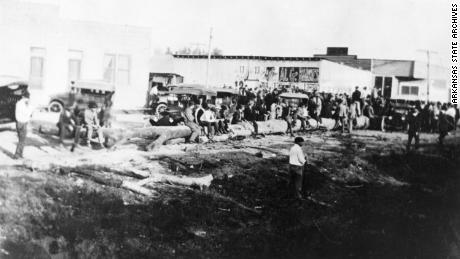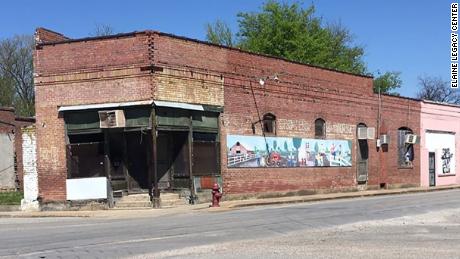They were among the hundreds of black people murdered in the first days of October 1919 by white mobs and government troops who poured into the small farming community on the Arkansas Delta after false rumors of an uprising by black sharecroppers. This week, Miller and other members of the Elaine Massacre Memorial board will unveil a monument in Helena, Arkansas, to commemorate the killings.It will be the first of its kind to honor the victims of the massacre and, its supporters hope, a first step toward acknowledging and healing from the tragedy. "It was an ugly part of our history and it was something that most people didn't want to remember," Miller said. "I think everybody's realizing that there's more conversations that need to be had.""This is our contribution to the story."But as Helena's board moves forward, their new memorial has opened old wounds in the nearby town of Elaine, where the epicenter of the massacre was and where residents — after decades of watching their story go untold — say they should dictate how it is now shared. "The people in Helena who are the cultural, the financial and the political descendants of the white power structure who orchestrated and lied about the massacre will now pretend to commemorate it," one critic of the memorial, Arkansas pastor and judge Wendell Griffen, said.
The massacre
The Elaine Massacre was one of the bloodiest episodes in a string of similar clashes in which white men targeted black communities across the country in 1919. The events became known as "Red Summer." The killings in the Arkansas town began after white law enforcement officers discovered a secret September 30 meeting held by black sharecroppers from Phillips County — where both Helena and Elaine are located — who planned to unionize. White men from surrounding communities descended on Elaine, "destroying homes and businesses and attacking anyone in their path," the Equal Justice Initiative says. They were joined by white troops returning from war, according to the Central Arkansas Library System."They muster these men up and they send them as a force to crush the union," said Dr. Brian Mitchell, an assistant professor of history at the University of Arkansas at Little Rock. Some of the white mobs came from Helena, Mitchell said. More than 200 black people were killed and another 200 jailed and tortured in the attacks, according to the Arkansas State Archives. No white men were arrested for the killings, the professor said. More than 120 black people were charged with crimes following the Elaine killings and 12 black men were convicted of murder and sentenced to death, the state's archives say. Those sentences were later reversed with the help of the NAACP.
A town stuck in the past
The Helena monument is a first step toward acknowledging that part of history, Miller said. "What's incredibly powerful is the fact that you have … the descendants whose family members were victims and those whose family members potentially had involvement in the posse … now joining together," he says. "That's the strongest statement you can make about unity and the progress we are making."But others are hesitant of such claims of progress."Helena did nothing over the past 100 years to deal with the trauma of the people of Elaine whose relatives were massacred," pastor and judge Griffen said. The town of Elaine feels like "you have been put into a time warp," he said, with the racial divide still very much present today. "You've got the economic center of the community controlled by whites and the black people are very much in a servile worker situation," Griffen said. "Like segregation never ended." There are still disputes about who owned much of the land in Elaine in 1919. Residents say a big part was owned by black people, but professor Mitchell says there's been virtually no evidence of that. On the contrary, he believes the land was owned by a "handful of white men."Residents in Elaine believe their land was stolen during the massacre and they're holding on to hope it will be restored, says Rev. Mary Olson, the founder of the Elaine Legacy Center. The center has been collecting oral histories from people living in Elaine, many of whom are descendants of the massacre's survivors."The theme of many of the oral histories is 'give it back,'" Olson, who is white, said. "(There are) remnants of land that was once owned by African Americans but it's much smaller," she says.Today, Elaine is a majority-black town of less than 600 where more than 40% of the residents live below the poverty level. Helena, in comparison, has a few more than 10,000 residents. "We are here, if not the poorest county in America, very close to it," Olson said. "We need here to really get beyond 1919." There are no schools in town, she says — just one preschool. And on Elaine's Main Street, one bank stands along several nonprofits, businesses, a restaurant and a few empty buildings. Along the highway, Olson says there are tractor and agricultural supply stores — proof the community is still very much a farming town, just like it used to be.
There are still disputes about who owned much of the land in Elaine in 1919. Residents say a big part was owned by black people, but professor Mitchell says there's been virtually no evidence of that. On the contrary, he believes the land was owned by a "handful of white men."Residents in Elaine believe their land was stolen during the massacre and they're holding on to hope it will be restored, says Rev. Mary Olson, the founder of the Elaine Legacy Center. The center has been collecting oral histories from people living in Elaine, many of whom are descendants of the massacre's survivors."The theme of many of the oral histories is 'give it back,'" Olson, who is white, said. "(There are) remnants of land that was once owned by African Americans but it's much smaller," she says.Today, Elaine is a majority-black town of less than 600 where more than 40% of the residents live below the poverty level. Helena, in comparison, has a few more than 10,000 residents. "We are here, if not the poorest county in America, very close to it," Olson said. "We need here to really get beyond 1919." There are no schools in town, she says — just one preschool. And on Elaine's Main Street, one bank stands along several nonprofits, businesses, a restaurant and a few empty buildings. Along the highway, Olson says there are tractor and agricultural supply stores — proof the community is still very much a farming town, just like it used to be.  Olson hopes the Elaine Legacy Center will help spur change. She's set on restoring many of the town's abandoned sites, creating a museum, opening up a welcome center and expanding after-school youth programs. She says she wants to begin sharing the oral histories they've been collecting from descendants who still live in Elaine today. There is progress already being made, Olson says, and hopes the town will soon become a prosperous community "with the recognition of being the epicenter of the massacre and the tourism and research that go with that."
Olson hopes the Elaine Legacy Center will help spur change. She's set on restoring many of the town's abandoned sites, creating a museum, opening up a welcome center and expanding after-school youth programs. She says she wants to begin sharing the oral histories they've been collecting from descendants who still live in Elaine today. There is progress already being made, Olson says, and hopes the town will soon become a prosperous community "with the recognition of being the epicenter of the massacre and the tourism and research that go with that."
Told to move on
Until now, Mitchell and some Elaine residents said, descendants of the victims have had to live as though the massacre never happened. "It didn't behooRead More – Source






